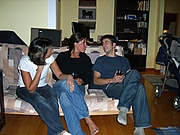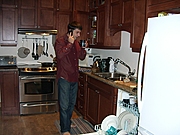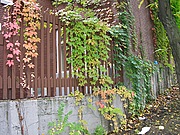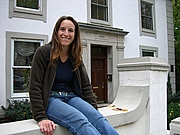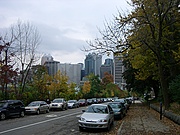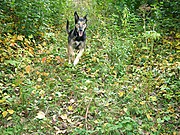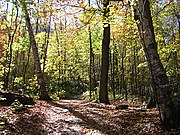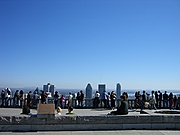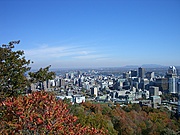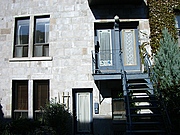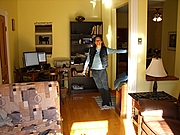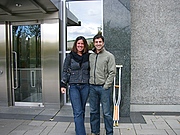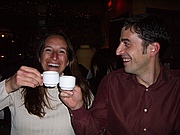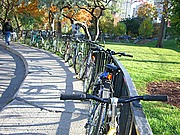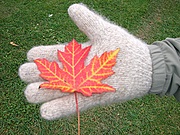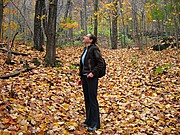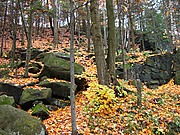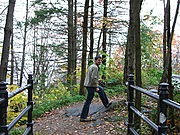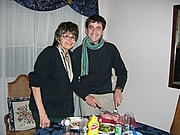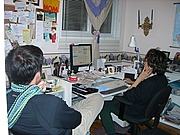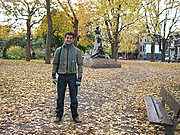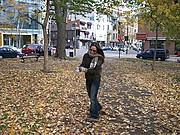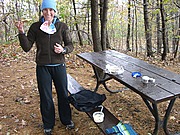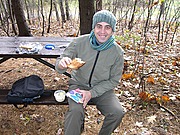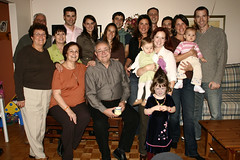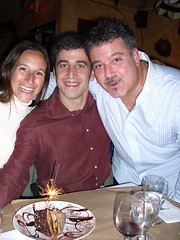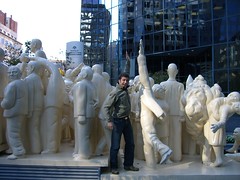I've long held fantasies of living in the jungle amidst untouched, thriving wilderness. More recently, while studying satellite imagery, I was drawn to the last big swath of land on Earth that's green: The Amazon Jungle.
It's immense - from the Andean mountains in Ecuador east through Peru and Brazil, right to the Atlantic Ocean. Millions of acres of rain forest, mostly untamed and some of it still unexplored by modern man.
For the last two weeks, we set out for our first foray deep into the Ecuadorian jungle. And what a tasty treat it was...
Getting There
The ten hour overnight bus east from Quito over and down the Andean mountains to Coca was our first in South America. The roads between cities are unpaved, potholed and muddy, making the ride a jarring experience - slamming us into each other as one wheel or another dips into a dark crevasse. Adding to the experience is the legendary Latin American man's machismo... Despite driving along the curvy mountain switchbacks sided by unprotected vertical cliffs, our driver raced along as if he were in a rally race. Our bags and bodies slid into the aisle and then back into the window, turn after turn. Needless to say, we didn't sleep much...




From Coca, where the last roads end, we rode downstream on the Napo river for seven hours in a motorized canoe most of the way to Peru. Along the river's banks we saw lush plants and on occasion the huts of an indigenous community or their children running along the river's edge waving excitedly, a testament to how few boats pass here. Most in the canoe were soaked by the splashing water, scrunched into fetal positions to keep the spray off their faces, I had migrated to the very front of the craft and lay comfortably face hanging over the bow - dry, warm and with a perma-grin enjoying the feeling of hovering over the water while being awed by the scenery.
Finally turning into the much smaller Yuturi river, we slowed to navigate the shallow winding way. Before long we could see a clearing on the bank revealing our lodge. Constructed of bamboo on stilts and surrounded by smaller sleeping huts, we immediately took a liking to the primitiveness and authenticity of the place.
First Impressions
The sound of the jungle is perhaps more striking than the sight. A symphony of bird songs is ever present from an unknown number of bird species. Many parrots, laurels, condors, toucans and a dozen more unidentified species were there at each glance skyward. One, the Oropendola, was particularly interesting - perched on a branch, it would lean forward, swing nearly upside down letting out the most impressive of songs before opening its wings and righting itself - like a pendulum.
The birds would wake us at around 6:00 and we'd crawl out from under our bug netted bed, walk across the bamboo floor through whose boards you could see the ground a meter beneath and hesitatingly enter the cold shower to wash off yesterday's layer of DEET insect repellent, only to dry off and reapply another layer before stepping out into the bright and lively morning.
Spanish Classes in the Jungle
Each morning, we studied Spanish one to one with our teachers Paulo and Zayra who accompanied us into the jungle from the school in Quito. For 4 to 4.5 intense hours, we sat overlooking the river, listening to the birds singing and studied Spanish grammar, conjugation in the present/past/future/imperative tenses, and new vocabulary and expressions. There was constantly a feeling of being behind the curve, as the pace was fast, but ultimately, so was the learning. After each session, we wearily gathered for lunch with the handful of others staying at the lodge. Jovial banter ensued and friendships formed.
When we arrived, we had difficulty understanding almost everything. After two weeks, we not only understood most of what was said, but both felt comfortable conversing with the locals. An amazing feeling!
Jungle Excursions
The afternoons were reserved for excursions into the jungle. Sometimes we walked well trodden ancient riverside trails that run a thousand kilometers, or sloshed through barely passable mud on foot led by a machete slashing native guide who opened the way for us, or gently paddled canoes down the river sighting the wildlife.
One excursion had me swinging from a vine yodeling like Tarzan. That, and my propensity to want to try everything that the jungle offered had some affectionately nickname me Tarzan and Joanne Jane.
Each excursion yielded new secrets, from the Sang de Dragon, a tree sap that's the jungle's version of insect repellent, another creamy sap that's used to treat all kinds of stomach and digestive problems, the garlic of the jungle, a leaf that tastes just like garlic, and that's a snake repellent when rubbed on skin, or which kind of palm's young leaves are used to make rope and which are used to make the waterproof roofs for native huts.
We saw all sorts of wildlife in their native habitat: monkeys (one from a family who came to check out our passing canoe positioned itself right over me in the trees and pee'd on me!), birds (including the toucan with its freakishly large beak),
piranhas (I caught one - delicious on the grill, kept the jaw/teeth as a souvenir),
crocodile (well, just its eye, the rest of it stayed submerged),
turtle, some
rodent-like animals the size of a poodle,
tarantulas (one crawled all over a companion - apparently tame as long as you don't touch its hair, which many are allergic to, and which can kill it if you have any creams on your hands!) and all sorts of small and large
spiders,
lizards and
salamanders,
ants with massive pincers (used as sutures for cuts - they bite and then their bodies are ripped off leaving the pincers squeezing the wound closed!), the massive Congo ant (two centimeters long, whose sting is debilitatingly painful and results in several days of fever), the
citrus ant (which lives
inside the thin branches of a particular bush, and when we ate them alive, we realized how they got their name. They had an intensely strong citrus taste!),
stick insects (indistinguishable from a thin tree branch), all sorts of colorful
butterflies,
centipedes and
millipedes, one large
winged insect as long as my hand with antennas twice that length, and lots of
frogs (one which hopped onto Joanne's hand and stayed there during a one hour walk),
cockroaches, a few small tree
snakes (but not the famed massive anaconda), a green
parakeet (that landed on my shoulder and insisted on a lick of my yogurt one breakfast) - and much, much more...
Most of these are invisible to the untrained eye (ours!) but to our guide, an indigenous Quechuan man, every few steps forward yielded another something interesting to reveal to us where a moment ago there appeared to be nothing but tangled plants.
Harmony and Disharmony
Strikingly, all of these plants and animals seemed to live in harmony - each type of plant growing next to another, none taking over all the space and strangling its neighbors. No one type of animal dominates - countless species living together in nature's balance.
Never before has man's rejection of nature and his tendency to live apart from nature been so blatantly obvious to me. Man tends to blanket himself so completely over land that today's cities have nothing but man in them. I once read that the most prolifically spreading virus on earth is man himself. After living all of my life in man-made species homogeneity, it was so refreshing to be surrounded by life's thriving diversity and witness natural balance.
Having said that, it's obvious that even the deep jungle is not immune to man's spread. The presence of the petroleros (oil company men) is felt here. Larger and larger swaths of indigenous land is being bought up by the oil companies who drill for oil, spill that oil into the rivers, polluting them to the point where the large one, the Napo can no longer support fish life. And this is the very beginning of the Amazon river ecosystem. The Napo flows downstream into the Amazon and out into the Atlantic, getting more inhospitable as it flows. The fish, which were the indiginous communities' staple food for millenia, is now gone. They have had to enter the money economy to purchase their food. It's really sad.
Mosquitoes
The mighty mosquito is the mightiest in the jungle. Despite our thrice daily application of DEET, we scratched our dozen daily new bites, sometimes to the point of bleeding. These suckers can make you ITCH! One particularly bad afternoon, Joanne emerged from a hammock with fifty-ish bites on her sides and back. She looked like she had a bad case of chicken pox!
Jungle River Fun
Seeing my fascination with his canoeing skills, our native guide taught me how to row and navigate the river. One of my favorite activities was to take a canoe out, rowing slowly and enjoy exploring the various nooks and crannies of the river. I'd often be found cruising back to the lodge just as the sun was setting sporting a wide and glowing smile.
The first of my swims in the river took quite some courage. The Yuturi river is completely opaque from the swirling silt. You can't see even a foot into the water, but you know that there's all kinds of critters in there. But after the first dive in and precarious swim, I realized that while I can't see any of the fish, they can see me, and do their best to avoid the big thing that could eat them. By the end, frolicing in the river was a daily adventure.
As was a daily swing and occasional nap in the hammocks hanging near the river's edge, where I now lay dreaming of the next jungle adventure...
 You see, my trusty Thinkpad X61 Tablet had run out of disk space back
in Thailand so I ordered a
You see, my trusty Thinkpad X61 Tablet had run out of disk space back
in Thailand so I ordered a ![Photo: Photo taken 2007/12/20 at 04:55 [CIMG4402]](../attachments/350-1_2007-12-20_04-55-58_EX-S600-_CIMG4402-0128.jpg)
![Photo: Photo taken 2008/01/20 at 19:24 [CIMG5393]](../attachments/350-20_2008-01-20_19-24-40_EX-S600-_CIMG5393-0128.jpg)
![Photo: Photo taken 2007/12/28 at 15:17 [CIMG4788]](../attachments/350-2_2007-12-28_15-17-26_EX-S600-_CIMG4788-0128.jpg)
![Photo: Photo taken 2007/12/28 at 16:08 [CIMG4812]](../attachments/350-6_2007-12-28_16-08-36_EX-S600-_CIMG4812-0128.jpg)
![Photo: Photo taken 2008/01/20 at 10:26 [CIMG5350]](../attachments/350-17_2008-01-20_10-26-34_EX-S600-_CIMG5350-0128.jpg)
![Photo: Photo taken 2008/01/20 at 08:49 [CIMG5341]](../attachments/350-16_2008-01-20_08-49-48_EX-S600-_CIMG5341-0128.jpg)
![Photo: Photo taken 2008/01/06 at 14:34 [CIMG5039]](../attachments/350-8_2008-01-06_14-34-18_EX-S600-_CIMG5039-0128.jpg)
![Photo: Photo taken 2008/01/06 at 14:34 [CIMG5040]](../attachments/350-9_2008-01-06_14-34-38_EX-S600-_CIMG5040-0128.jpg)
![Photo: Photo taken 2008/01/09 at 20:10 [CIMG5104]](../attachments/350-12_2008-01-09_20-10-24_EX-S600-_CIMG5104-0128.jpg)
![Photo: Photo taken 2008/01/09 at 20:38 [CIMG5126]](../attachments/350-13_2008-01-09_20-38-58_EX-S600-_CIMG5126-0128.jpg)
![Photo: Photo taken 2008/01/09 at 21:06 [CIMG5135]](../attachments/350-14_2008-01-09_21-06-14_EX-S600-_CIMG5135-0128.jpg)
![Photo: Photo taken 2008/01/09 at 21:25 [CIMG5136]](../attachments/350-15_2008-01-09_21-25-48_EX-S600-_CIMG5136-0128.jpg)
![Photo: Photo taken 2008/01/09 at 18:16 [CIMG5083]](../attachments/350-11_2008-01-09_18-16-48_EX-S600-_CIMG5083-0128.jpg)
![Photo: Photo taken 2008/01/05 at 13:18 [CIMG5028]](../attachments/350-7_2008-01-05_13-18-06_EX-S600-_CIMG5028-0128.jpg)
![Photo: Photo taken 2008/01/22 at 15:34 [CIMG5395]](../attachments/350-21_2008-01-22_15-34-32_EX-S600-_CIMG5395-0128.jpg)
![Photo: Photo taken 2008/01/22 at 18:41 [CIMG5411]](../attachments/350-22_2008-01-22_18-41-16_EX-S600-_CIMG5411-0128.jpg)
![Photo: Photo taken 2007/12/28 at 15:43 [CIMG4797]](../attachments/350-3_2007-12-28_15-43-40_EX-S600-_CIMG4797-0128.jpg)
![Photo: Photo taken 2007/12/28 at 15:43 [CIMG4798]](../attachments/350-4_2007-12-28_15-43-44_EX-S600-_CIMG4798-0128.jpg)
![Photo: Photo taken 2007/12/28 at 16:02 [CIMG4808]](../attachments/350-5_2007-12-28_16-02-14_EX-S600-_CIMG4808-0128.jpg)
![Photo: Photo taken 2008/01/20 at 10:39 [CIMG5353]](../attachments/350-18_2008-01-20_10-39-40_EX-S600-_CIMG5353-0128.jpg)
![Photo: Photo taken 2008/01/20 at 11:21 [CIMG5359]](../attachments/350-19_2008-01-20_11-21-46_EX-S600-_CIMG5359-0128.jpg)
![Photo: Photo taken 2008/01/08 at 12:05 [CIMG5073]](../attachments/350-10_2008-01-08_12-05-28_EX-S600-_CIMG5073-0128.jpg)
![Photo: Photo taken 2007/11/26 at 18:03 [CIMG3725]](../attachments/332-2_2007-11-26_18-03-22_EX-S600-_CIMG3725-0128.jpg)
![Photo: Photo taken 2007/11/26 at 04:52 [CIMG3719]](../attachments/332-1_2007-11-26_04-52-56_EX-S600-_CIMG3719-0128.jpg)
![Photo: Photo taken 2007/11/26 at 18:37 [CIMG3727]](../attachments/332-3_2007-11-26_18-37-10_EX-S600-_CIMG3727-0128.jpg)
![Photo: Photo taken 2007/11/26 at 19:47 [CIMG3737]](../attachments/332-4_2007-11-26_19-47-38_EX-S600-_CIMG3737-0128.jpg)
![Photo: Photo taken 2007/11/26 at 20:00 [CIMG3744]](../attachments/332-5_2007-11-26_20-00-26_EX-S600-_CIMG3744-0128.jpg)
![Photo: Photo taken 2007/11/27 at 03:31 [CIMG3762]](../attachments/332-6_2007-11-27_03-31-48_EX-S600-_CIMG3762-0128.jpg)
![Photo: Photo taken 2007/11/27 at 04:24 [CIMG3770]](../attachments/332-7_2007-11-27_04-24-30_EX-S600-_CIMG3770-0128.jpg)
![Photo: Photo taken 2007/11/21 at 20:31 [CIMG3596]](../attachments/331-1_2007-11-21_20-31-28_EX-S600-_CIMG3596-0128.jpg)
![Photo: Photo taken 2007/11/22 at 15:43 [CIMG3616]](../attachments/331-2_2007-11-22_15-43-20_EX-S600-_CIMG3616-0128.jpg)
![Photo: Photo taken 2007/11/22 at 17:00 [CIMG3631]](../attachments/331-3_2007-11-22_17-00-44_EX-S600-_CIMG3631-0128.jpg)
![Photo: Photo taken 2007/11/22 at 17:08 [CIMG3635]](../attachments/331-4_2007-11-22_17-08-32_EX-S600-_CIMG3635-0128.jpg)
![Photo: Photo taken 2007/11/22 at 17:16 [CIMG3639]](../attachments/331-5_2007-11-22_17-16-32_EX-S600-_CIMG3639-0128.jpg)
![Photo: Photo taken 2007/11/22 at 20:12 [CIMG3662]](../attachments/331-6_2007-11-22_20-12-46_EX-S600-_CIMG3662-0128.jpg)
![Photo: Photo taken 2007/11/22 at 20:15 [CIMG3665]](../attachments/331-7_2007-11-22_20-15-32_EX-S600-_CIMG3665-0128.jpg)
![Photo: Photo taken 2007/11/22 at 22:41 [CIMG3674]](../attachments/331-8_2007-11-22_22-41-32_EX-S600-_CIMG3674-0128.jpg)
![Photo: Photo taken 2007/11/23 at 18:26 [CIMG3684]](../attachments/331-9_2007-11-23_18-26-58_EX-S600-_CIMG3684-0128.jpg)
![Photo: Photo taken 2007/11/23 at 20:45 [CIMG3700]](../attachments/331-10_2007-11-23_20-45-16_EX-S600-_CIMG3700-0128.jpg)
![Photo: Photo taken 2007/10/15 at 15:52 [CIMG2338]](../attachments/329-3_2007-10-15_15-52-26_EX-S600-_CIMG2338-0128.jpg)
![Photo: Photo taken 2007/10/11 at 14:50 [CIMG2225]](../attachments/329-1_2007-10-11_14-50-04_EX-S600-_CIMG2225-0128.jpg)
![Photo: Photo taken 2007/10/13 at 16:23 [CIMG2323]](../attachments/329-2_2007-10-13_16-23-50_EX-S600-_CIMG2323-0128.jpg)
![Photo: Photo taken 2007/10/15 at 17:16 [CIMG2356]](../attachments/329-4_2007-10-15_17-16-36_EX-S600-_CIMG2356-0128.jpg)
![Photo: Photo taken 2007/10/17 at 14:50 [CIMG2376]](../attachments/329-5_2007-10-17_14-50-12_EX-S600-_CIMG2376-0128.jpg)
![Photo: Photo taken 2007/10/17 at 15:11 [CIMG2377]](../attachments/329-6_2007-10-17_15-11-36_EX-S600-_CIMG2377-0128.jpg)
![Photo: Photo taken 2007/10/21 at 14:17 [CIMG2443]](../attachments/329-7_2007-10-21_14-17-22_EX-S600-_CIMG2443-0128.jpg)
![Photo: Photo taken 2007/10/21 at 16:01 [CIMG2447]](../attachments/329-8_2007-10-21_16-01-58_EX-S600-_CIMG2447-0128.jpg)
![Photo: Photo taken 2007/10/21 at 17:26 [CIMG2457]](../attachments/329-9_2007-10-21_17-26-24_EX-S600-_CIMG2457-0128.jpg)
![Photo: Photo taken 2007/10/22 at 15:30 [CIMG2470]](../attachments/329-10_2007-10-22_15-30-42_EX-S600-_CIMG2470-0128.jpg)
![Photo: Photo taken 2007/10/23 at 17:36 [CIMG2495]](../attachments/329-11_2007-10-23_17-36-30_EX-S600-_CIMG2495-0128.jpg)
![Photo: Photo taken 2007/10/23 at 17:39 [CIMG2499]](../attachments/329-12_2007-10-23_17-39-36_EX-S600-_CIMG2499-0128.jpg)
![Photo: Photo taken 2007/10/23 at 21:02 [CIMG2504]](../attachments/329-13_2007-10-23_21-02-08_EX-S600-_CIMG2504-0128.jpg)
![Photo: Photo taken 2007/10/24 at 16:31 [CIMG2509]](../attachments/329-14_2007-10-24_16-31-08_EX-S600-_CIMG2509-0128.jpg)
![Photo: Photo taken 2007/10/24 at 16:51 [CIMG2517]](../attachments/329-15_2007-10-24_16-51-52_EX-S600-_CIMG2517-0128.jpg)
![Photo: Photo taken 2007/10/24 at 17:16 [CIMG2520]](../attachments/329-16_2007-10-24_17-16-14_EX-S600-_CIMG2520-0128.jpg)
![Photo: Photo taken 2007/10/24 at 17:45 [CIMG2522]](../attachments/329-17_2007-10-24_17-45-38_EX-S600-_CIMG2522-0128.jpg)
![Photo: Photo taken 2007/10/28 at 10:28 [CIMG2535]](../attachments/329-18_2007-10-28_10-28-52_EX-S600-_CIMG2535-0128.jpg)
![Photo: Photo taken 2007/11/02 at 11:07 [CIMG2575]](../attachments/329-19_2007-11-02_11-07-32_EX-S600-_CIMG2575-0128.jpg)
![Photo: Photo taken 2007/10/12 at 16:53 [CIMG2300]](../attachments/328-10_2007-10-12_16-53-14_EX-S600-_CIMG2300-0128.jpg)
![Photo: Photo taken 2007/10/15 at 13:17 [CIMG2334]](../attachments/328-13_2007-10-15_13-17-04_EX-S600-_CIMG2334-0128.jpg)
![Photo: Photo taken 2007/10/18 at 11:45 [CIMG2426]](../attachments/328-17_2007-10-18_11-45-02_EX-S600-_CIMG2426-0128.jpg)
![Photo: Photo taken 2007/10/14 at 14:25 [CIMG2327]](../attachments/328-11_2007-10-14_14-25-22_EX-S600-_CIMG2327-0128.jpg)
![Photo: Photo taken 2007/10/14 at 15:46 [CIMG2329]](../attachments/328-12_2007-10-14_15-46-48_EX-S600-_CIMG2329-0128.jpg)
![Photo: Photo taken 2007/10/12 at 10:32 [CIMG2230]](../attachments/328-1_2007-10-12_10-32-56_EX-S600-_CIMG2230-0128.jpg)
![Photo: Photo taken 2007/10/12 at 10:46 [CIMG2238]](../attachments/328-2_2007-10-12_10-46-30_EX-S600-_CIMG2238-0128.jpg)
![Photo: Photo taken 2007/10/12 at 10:51 [CIMG2243]](../attachments/328-3_2007-10-12_10-51-14_EX-S600-_CIMG2243-0128.jpg)
![Photo: Photo taken 2007/10/12 at 11:07 [CIMG2255]](../attachments/328-4_2007-10-12_11-07-58_EX-S600-_CIMG2255-0128.jpg)
![Photo: Photo taken 2007/10/12 at 11:09 [CIMG2257]](../attachments/328-5_2007-10-12_11-09-40_EX-S600-_CIMG2257-0128.jpg)
![Photo: Photo taken 2007/10/12 at 11:44 [CIMG2269]](../attachments/328-6_2007-10-12_11-44-30_EX-S600-_CIMG2269-0128.jpg)
![Photo: Photo taken 2007/10/12 at 12:11 [CIMG2288]](../attachments/328-7_2007-10-12_12-11-20_EX-S600-_CIMG2288-0128.jpg)
![Photo: Photo taken 2007/10/12 at 12:13 [CIMG2291]](../attachments/328-8_2007-10-12_12-13-04_EX-S600-_CIMG2291-0128.jpg)
![Photo: Photo taken 2007/10/12 at 12:23 [CIMG2292]](../attachments/328-9_2007-10-12_12-23-08_EX-S600-_CIMG2292-0128.jpg)
![Photo: Photo taken 2007/10/17 at 17:58 [CIMG2406]](../attachments/328-14_2007-10-17_17-58-42_EX-S600-_CIMG2406-0128.jpg)
![Photo: Photo taken 2007/10/17 at 18:17 [CIMG2418]](../attachments/328-15_2007-10-17_18-17-44_EX-S600-_CIMG2418-0128.jpg)
![Photo: Photo taken 2007/10/17 at 18:22 [CIMG2420]](../attachments/328-16_2007-10-17_18-22-12_EX-S600-_CIMG2420-0128.jpg)
![Photo: Photo taken 2007/09/26 at 14:08 [CIMG1738]](../attachments/323-1_2007-09-26_14-08-40_EX-S600-_CIMG1738-0128.jpg)
![Photo: Photo taken 2007/09/26 at 18:14 [CIMG1742]](../attachments/323-2_2007-09-26_18-14-20_EX-S600-_CIMG1742-0128.jpg)
![Photo: Photo taken 2007/09/27 at 13:34 [CIMG1749]](../attachments/323-3_2007-09-27_13-34-42_EX-S600-_CIMG1749-0128.jpg)
![Photo: Photo taken 2007/09/28 at 11:36 [CIMG1769]](../attachments/323-4_2007-09-28_11-36-28_EX-S600-_CIMG1769-0128.jpg)
![Photo: Photo taken 2007/09/28 at 11:40 [CIMG1780]](../attachments/323-5_2007-09-28_11-40-20_EX-S600-_CIMG1780-0128.jpg)
![Photo: Photo taken 2007/09/28 at 12:36 [CIMG1783]](../attachments/323-6_2007-09-28_12-36-56_EX-S600-_CIMG1783-0128.jpg)
![Photo: Photo taken 2007/09/28 at 12:38 [CIMG1785]](../attachments/323-7_2007-09-28_12-38-16_EX-S600-_CIMG1785-0128.jpg)
![Photo: Photo taken 2007/09/28 at 13:56 [CIMG1788]](../attachments/323-8_2007-09-28_13-56-54_EX-S600-_CIMG1788-0128.jpg)
![Photo: Photo taken 2007/09/28 at 14:30 [CIMG1794]](../attachments/323-9_2007-09-28_14-30-44_EX-S600-_CIMG1794-0128.jpg)
![Photo: Photo taken 2007/09/28 at 15:38 [CIMG1803]](../attachments/323-10_2007-09-28_15-38-08_EX-S600-_CIMG1803-0128.jpg)
![Photo: Photo taken 2007/09/28 at 18:31 [CIMG1844]](../attachments/323-11_2007-09-28_18-31-26_EX-S600-_CIMG1844-0128.jpg)

























































































































































































































![Photo: Photo taken 2006/10/21 at 15:26 [CIMG3960]](../attachments/221-2_2006-10-21_15-26-56_EX_S500_CIMG3960-0128.jpg)







